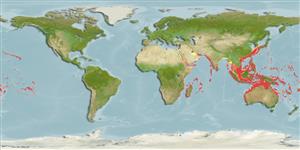Classification / Names
Common names from other countries
Main reference
Size / Weight / Age
Max length : 100.0 cm FL male/unsexed; (Ref. 168); common length : 60.0 cm FL male/unsexed; (Ref. 168); max. published weight: 14.0 kg (Ref. 30874)
Length at first maturity
Lm ?, range 40 - 65 cm
Environment
Marine; pelagic-neritic; oceanodromous (Ref. 51243); depth range 0 - 200 m (Ref. 54439)
Climate / Range
Tropical; 18°C - 29°C (Ref. 168), preferred 28°C (Ref. 107945); 35°N - 38°S, 32°E - 137°W (Ref. 54439)
Distribution
Indo-West Pacific: in warm waters including oceanic islands and archipelagos. A few stray specimens have been collected in the Eastern Central Pacific. Highly migratory species, Annex I of the 1982 Convention on the Law of the Sea (Ref. 26139).
Countries | FAO areas | Ecosystems | Occurrences | Introductions
Short description
Dorsal
spines
(total): 10 - 15;
Dorsal
soft rays
(total): 11-15;
Anal
spines: 0;
Anal
soft rays: 11 - 15;
Vertebrae: 39. Swim bladder absent. No trace of vertebral protuberances. Anterior spines of first dorsal fin much higher than those mid-way. Interpelvic process small and bifid. Body naked except for corselet and lateral line. Posterior portion of the back with a pattern of broken oblique stripes.
IUCN Red List Status (Ref. 115185)
Threat to humans
Reports of ciguatera poisoning (Ref. 30911)
Human uses
Fisheries: highly commercial; gamefish: yes
Tools
Special reports
Download XML
Internet sources
Estimates of some properties based on models
Phylogenetic diversity index
PD50 = 0.6250 many relatives (e.g. carps) 0.5 - 2.0 few relatives (e.g. lungfishes)
Trophic Level
4.5 ±0.0 se; Based on diet studies.
Resilience
Medium, minimum population doubling time 1.4 - 4.4 years (K=0.4-0.5; tm=3; Fec=210,000)
Vulnerability
Moderate vulnerability (37 of 100)
Price category
